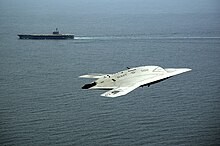

The Unmanned Carrier-Launched Airborne Surveillance and Strike (UCLASS) was a United States Navy program to develop an autonomous carrier-based unmanned combat aerial vehicle providing an unmanned intelligence and strike asset to the fleet.[1] After debate over whether the UCLASS should primarily focus on stealthy bombing or scouting, the Pentagon instead changed the program entirely into the Carrier-Based Aerial-Refueling System (CBARS) to create a UAV for aerial refueling duties to extend the range of manned fighters,[2] which led to the Boeing MQ-25 Stingray.
- ^ Mabus, Ray (21 January 2014). "Future Platforms: Unmanned Naval Operations". War on the Rocks.
- ^ Good-Bye, UCLASS; Hello, Unmanned Tanker, More F-35Cs In 2017 Budget - Breakingdefense.com, 1 February 2016